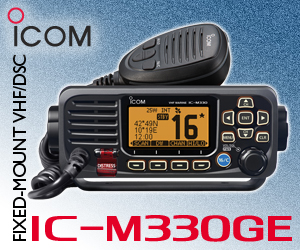-202403121604.gif)












| Laser XD 203301 Upminster |
 |
| Laurent Giles 'Jolly Boat' Exeter |
 |
| J24 (Sail No. 4239) Dartmouth |
 |
List classes of boat for sale |
Tacking on a mark, room to keep clear? |
Post Reply 
|
Page <1234> |
| Author | ||
Fatboi 
Posting king 
Joined: 09 Aug 16 Location: Hampshire Online Status: Offline Posts: 189 |
 Post Options Post Options
 Quote Quote  Reply Reply
 Topic: Tacking on a mark, room to keep clear? Topic: Tacking on a mark, room to keep clear?Posted: 21 May 19 at 11:00am |
|
|
"Mark-Room Room for a boat to leave a mark on the required side. Also,
(a) room to sail to the mark when her proper course is to sail close to it,
and
(b) room to round the mark as necessary to sail the course.
However, mark-room for a boat does not include room to tack unless she is
overlapped inside and to windward of the boat required to give mark-room
and she would be fetching the mark after her tack"
http://www.sailing.org/tools/documents/WorldSailingRRS20172020new-[24067].pdf
If blue goes into the zone clear ahead and they can get tight to the mark, then realistically they can tack without infringing yellow. They will start the tack as the bow passes the mark and in order for yellow to round they would follow blue line. If blue cannot get tight to the mark so when they go for a tack, yellow would have to avoid, then blue should wait for yellow to round. The other scenario and common at a ww mark is blue can call room for and stbd boats and use them as a way to execute a tack legally. Yellow would then have to peel low to get over the layline and round, or tack to allow blue room for the stbd boat. Edited by Fatboi - 21 May 19 at 11:52am |
||
 |
||
Sam.Spoons 
Really should get out more 
Joined: 07 Mar 12 Location: Manchester UK Online Status: Offline Posts: 3398 |
 Post Options Post Options
 Quote Quote  Reply Reply
 Posted: 21 May 19 at 11:44am Posted: 21 May 19 at 11:44am |
|
|
Blue is clear ahead throughout the sequence?
|
||
|
Spice 346 "Flat Broke"
Blaze 671 "supersonic soap dish" |
||
 |
||
Fatboi 
Posting king 
Joined: 09 Aug 16 Location: Hampshire Online Status: Offline Posts: 189 |
 Post Options Post Options
 Quote Quote  Reply Reply
 Posted: 21 May 19 at 11:52am Posted: 21 May 19 at 11:52am |
|
You are 100% correct... Post edited to sort out
|
||
 |
||
Brass 
Really should get out more 
Joined: 24 Mar 08 Location: Australia Online Status: Offline Posts: 1146 |
 Post Options Post Options
 Quote Quote  Reply Reply
 Posted: 21 May 19 at 12:09pm Posted: 21 May 19 at 12:09pm |
|
That's a question I've been struggling with for quite some time. Here's my best attempt at a background analysis. In the pre-1995 RRS room for an inside overlapped boat at a
mark was defined, within the room at marks and obstructions rule and included
‘space to tack or gybe when either is an integral part of the rounding or
passing manoeuvre’. Those pre-1995 RRS also provided that: ·
an inside overlapped boat approaching a mark was
entitled to room to pass the mark including ‘space to tack or gybe’ ·
a boat clear ahead approaching a mark that
tacked to round the mark was subject to the While Tacking right of way rule and
was NOT entitled to any ‘space to tack or gybe;. The 1995 rewrite of the RRS provided a general definition of
room in Definitions that did NOT
include ‘space to tack’, and ‘space to tack’ was not provided in the room at
marks and obstructions rule (rule 18), or elsewhere. The 1995 RRS provided that: ·
a boat that was overlapped inside before or when
reaching the two-length zone, was entitled to room to pass the mark, room as
defined in Definitions and not mentioning space to tack or gybe; ·
a boat that was clear ahead when she reached the
two-length zone remained the right of way boat even if an overlap is
established later, but if she tacked she ceased to have right of way and rule
13 applied. Seemingly the intention to privilege an inside overlapped
boat, over one clear ahead was preserved and the 1995 drafters thought that
room to pass the mark included room to tack without saying so. Cases 15 and 81, decided in 1966 and 1983, about mark-room
switching off in a tack, both concerned a boat clear ahead tacking, so were not
inconsistent with this view. Case 95 was
not decided until 2000. The 2005 rewrite of the RRS introduced the defined term mark-room and the three length zone.
All mention of right of way boat with respect to mark-room was deleted,
so that rule 18 only dealt with obligations to give mark-room, and no depended
on or changed any right of way obligations, reconciling Section A right of way
breaches with mark-room breaches by means of the exoneration mechanism. The definition of mark-room re-introduced the issue of
whether mark-room included room to tack by saying ‘mark-room does not include
room to tack unless the boat is overlapped to windward and on the inside of the
boat required to give mark-room’. This bespeaks an intention to maintain the privilege
accorded to an inside overlapped boat, but note the ‘back-handed’ wording
stating what mark-room does not include. These changes are consistent with the current wording of the
rules. In my opinion, whatever the intention of the drafters of the
rules may have been, according any form of mark-room to a boat, once she has
passed head to wind is outright contrary to rule 18.1, which disapplies the
whole of rule 18 to a boat that passes head to wind, as confirmed by Case 95. The negative formulation of the reference to
room to tack in the Definition of mark-room is completely insufficient to
displace the plain words of rule 18.1 and Case 95. |
||
 |
||
Eisvogel 
Posting king 

Joined: 09 Dec 16 Location: Birmingham Online Status: Offline Posts: 135 |
 Post Options Post Options
 Quote Quote  Reply Reply
 Posted: 21 May 19 at 12:32pm Posted: 21 May 19 at 12:32pm |
|
|
I don't know, but ongoing discussions like this indicate to me that the rules are rather too complicated. How can you process all this within a few seconds when approaching a mark? Especially if you're not an Olympic (or National) level sailor, but someone who goes round the cans at the weekend...
|
||
|
Enterprise 20361 (Eisvogel), Laser 102727 (Halcyon), Laser 121986
|
||
 |
||
JimC 
Really should get out more 

Joined: 17 May 04 Location: United Kingdom Online Status: Offline Posts: 6649 |
 Post Options Post Options
 Quote Quote  Reply Reply
 Posted: 21 May 19 at 12:43pm Posted: 21 May 19 at 12:43pm |
|
|
But what's the alternative?
Seems to me the choices are: - Rules that can cope with 95% of situations, necessarily fairly complex - what we have now. - Much simpler rules that rely on keeping boats out of close proximity - Colregs, which means no close quarters mark rounding. - Simplified rules that don't cover all situations, and an acceptance of "racing incidents" - no fault collisions. Like Motor racing. I'll stick with what we have as least worst... |
||
 |
||
Rupert 
Really should get out more 
Joined: 11 Aug 04 Location: Whitefriars sc Online Status: Offline Posts: 8956 |
 Post Options Post Options
 Quote Quote  Reply Reply
 Posted: 21 May 19 at 12:45pm Posted: 21 May 19 at 12:45pm |
|
|
In general, you don't have to process it all. Much of it is logical, like in inside boat having room, but not at the very last moment, as that wouldn't give the outside boat a clear picture as the mark is approached.
And if you are just ahead of someone, they can't really avoid you if you suddenly turn 90 degrees, so you aren't allowed to do it. Hence, you turn the boat a little first to change the situation and make the tack possible. After all, we use the rules to win, but they are there to prevent crashes too, and we are all very good at finding new situations to meet other boats. |
||
|
Firefly 2324, Puffin 229, Minisail 3446 Mirror 70686
|
||
 |
||
Guests 
Guest Group 
|
 Post Options Post Options
 Quote Quote  Reply Reply
 Posted: 21 May 19 at 1:02pm Posted: 21 May 19 at 1:02pm |
|
I found this in the 200 where you if you were clear ahead the boat would need to be really close behind for you not to be able to complete the tack and give them room to avoid. So you could just do a slow head up in to the tack, giving away 1/4 of a boat length to force them outside. If they're further back than that you can probably get your tack in and give them room to keep clear. But, in the 800 when you're reaching in on a fat lay at 12 knots and when you stop so much in a tack you feel quite vulnerable. Typically you'll slow to 2-3 knots and it'll take 1-2 second to go from head to wind to close hauled. A boat chasing in on the lay could be two boats lengths clear astern and still get a piece of you whilst tacking. Slowing down two boat lengths within a 3 boat length zone isn't a subtle manoeuvre and slowing down that much before a tack is a recipe for getting stuck in irons. So you effectively end up giving mark rounding position back to a boat 2 boats lengths clear astern for fear of breaking rule 13 or 15. Really, the boat clear astern should be able to pre-empt you tacking and avoid you in a similar way as they can pre-empt a gybe drop at a leeward mark and the closing speeds are even greater there. It's not like half way up the beat where they will have no idea you are about to make a significant course change and need the protection of rule 13, 15 and 16 to give them room to keep clear. Rule 18 specifically turns off those rules for roundings anyway? |
||
 |
||
Fatboi 
Posting king 
Joined: 09 Aug 16 Location: Hampshire Online Status: Offline Posts: 189 |
 Post Options Post Options
 Quote Quote  Reply Reply
 Posted: 21 May 19 at 1:14pm Posted: 21 May 19 at 1:14pm |
|
|
"18.2 Giving Mark-Room
(a) When boats are overlapped the outside boat shall give the
inside boat mark-room, unless rule 18.2(b) applies.
(b) If boats are overlapped when the first of them reaches the zone,
the outside boat at that moment shall thereafter give the inside
boat mark-room. If a boat is clear ahead when she reaches the
zone, the boat clear astern at that moment shall thereafter give
her mark-room."
Made the important part red. Does this not mean that the boat clear astern (Not overlapped at 3) shall give mark room and therefore allow the leading boat room to round? As the leading boat tacks and they are on a close hauled course, they are then on STBD, and so the following (Port) boat must still keep clear. If you are coming in on a 'fat lay' they surely would not be overlapped and would be following you in, so shouldn't really be too much of a drama. I am assuming your overstood and reaching in, so you would pass the mark while heading up to a close hauled course/tacking and for them to actually get to you, they would have to go through the mark.
|
||
 |
||
Guests 
Guest Group 
|
 Post Options Post Options
 Quote Quote  Reply Reply
 Posted: 21 May 19 at 1:45pm Posted: 21 May 19 at 1:45pm |
|
Thank you for the history. 18.1 turning off rule 18 for boats on opposite tacks on a beat makes complete sense. It stops port boats coming in on the layline. I know that happens at leeward marks, but there starboard boats can just bear away a little to afford room. Up wind they cannot head up without stopping and causing a pile up. However, the way it's worded seems to have some strange implications for boats reaching in to mark they shall tack around. 18.1 a) specifically makes the opposite tacks exemption for boats on a beat to windward... but then 18.1 b) seems to make opposite tacks exempt all the time. Does the diagram below change your rules interpretation? And if not, then what is the purpose of rule 18.1a)?  |
||
 |
||
Post Reply 
|
Page <1234> |
| Forum Jump | Forum Permissions  You cannot post new topics in this forum You cannot reply to topics in this forum You cannot delete your posts in this forum You cannot edit your posts in this forum You cannot create polls in this forum You cannot vote in polls in this forum |
Copyright ©2001-2010 Web Wiz
Change your personal settings, or read our privacy policy











 Printable Version
Printable Version Delicious
Delicious Digg
Digg Facebook
Facebook Furl
Furl Google
Google MySpace
MySpace Newsvine
Newsvine reddit
reddit StumbleUpon
StumbleUpon Twitter
Twitter Windows Live
Windows Live Yahoo Bookmarks
Yahoo Bookmarks Topic Options
Topic Options